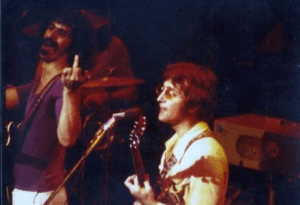Rock Stars You Probably Didn’t Know Are Missing Body Parts

Brian May, Tony Iommi, and Eddie Van Halen - Raised On Radio / YouTube
Being a rock star often sounds like the ultimate dream — endless creativity, roaring crowds, and the kind of fame that can outlive a lifetime. The spotlight, however, doesn’t always reveal the struggles behind the scenes. While many artists face emotional and mental battles, some have endured physical challenges that would stop most people in their tracks.
For a select few musicians, the journey to the stage came with a literal loss — missing limbs, fingers, or other body parts that are vital to performing. Whether from tragic accidents, illnesses, or birth conditions, these rockers refused to let their physical limitations define their music. They didn’t just adapt; they mastered their craft in ways that continue to inspire generations of artists and fans alike.
From classic legends to modern icons, these musicians proved that resilience can be just as powerful as talent. Their stories remind us that rock ’n’ roll has never been about perfection — it’s about spirit, defiance, and the will to keep creating no matter what’s been taken away.
Jerry Garcia Lost a Finger in a Childhood Accident
Jerry Garcia, the beloved leader of the Grateful Dead, inspired not just fans but an entire subculture of “Deadheads” who followed his every note. For three decades, Garcia’s improvisational genius and soulful guitar work defined the jam band movement. What few realize, however, is that the man behind the music played with one less finger than most.
When he was a child, Garcia and his older brother, Tiff, were chopping wood when tragedy struck. As Tiff later recalled, the two were playing around with an ax — Garcia kept placing his finger on the sawhorse and pulling it away at the last second. Unfortunately, after several close calls, Tiff missed his timing and accidentally struck his brother’s right hand, severing a portion of his finger.
Despite losing part of his finger at such a young age, Garcia didn’t let the injury hold him back. He went on to become one of the world’s most iconic guitarists, shaping a sound that blended folk, blues, and psychedelic rock. His physical limitation became irrelevant next to his artistry, proving that creativity can flourish even when the odds — or anatomy — are against you.
Tony Iommi Invented Heavy Metal Despite Losing His Fingertips
Before Tony Iommi helped define the sound of heavy metal with Black Sabbath, he worked as a factory welder in Birmingham, England. It was honest work, but one day, fate intervened in the most horrific way. Iommi was operating a massive metal press when the machine came down on his hand, severing the tips of his right-hand ring and middle fingers.
Doctors told him his guitar-playing days were over — devastating news for a man whose life revolved around music. But instead of accepting defeat, Iommi experimented with ways to keep playing. He crafted homemade prosthetics from melted plastic and leather, eventually developing fingertip caps that allowed him to fret the guitar strings again.
This accident, as tragic as it was, ended up shaping the sound of an entire genre. Iommi’s lighter touch and lower tunings, developed to accommodate his new playing style, became the foundation of heavy metal’s dark, heavy tone. His resilience turned pain into innovation, influencing countless musicians who came after him.
Rick Allen Continued to Drum With Only One Arm
Rick Allen of Def Leppard faced one of the most shocking physical challenges in rock history. On New Year’s Eve in 1984, while driving near his hometown of Sheffield, England, Allen lost control of his Corvette and crashed into a wall. The accident ejected him from the vehicle and severed his left arm, an unimaginable loss for any drummer.
Most would have walked away from their career, but Allen refused to quit. After a month in the hospital, he began retraining himself to play drums using his remaining arm and both feet. With the help of engineers, he developed a custom electronic drum kit that allowed him to play complex rhythms through foot pedals that triggered drum sounds electronically.
When Def Leppard returned to the stage in 1986, Allen stunned audiences with his performance. His determination not only saved his career but also inspired millions, proving that perseverance could overcome even the most devastating setbacks. Today, he remains one of rock’s most admired survivors.
Paul Stanley Was Born Without a Fully Formed Ear
KISS frontman Paul Stanley, known to fans as the Starchild, became a rock icon behind his star-shaped makeup and larger-than-life performances. But long before he was selling out arenas, Stanley lived with a congenital condition known as microtia — meaning his right ear was underdeveloped and he was nearly deaf on that side.
The condition left him self-conscious as a child and made it difficult to hear music in stereo. Despite these obstacles, Stanley pursued his passion relentlessly, developing a vocal style and stage presence that would define KISS’s image. His charisma and talent overshadowed any physical limitation he faced.
As an adult, Stanley underwent reconstructive surgery to create a new ear using cartilage from his rib cage. The procedure not only restored some of his hearing but also gave him newfound confidence. His story stands as a reminder that even physical imperfections can’t silence true rock ’n’ roll ambition.
https://twitter.com/KISSopolis/status/1976101053151182898
James “Munky” Shaffer Picked Up Guitar After a Finger Injury
Korn guitarist James “Munky” Shaffer didn’t start playing music out of casual curiosity — he picked up the guitar as a form of recovery. As a teenager, he tried to sneak out of his house to attend a party, but his plan took a painful turn. When the bike chain on his bicycle came loose, he reached down to fix it — and the moving chain caught his left index finger, severely injuring it.
Doctors recommended that he take up an instrument to help regain movement and sensation in the damaged finger. What began as therapy soon became an obsession. Shaffer poured himself into learning the guitar, eventually helping define Korn’s dark, down-tuned sound that came to dominate the nu-metal era.
His accident, though traumatic, ultimately shaped his musical destiny. The very injury that could have held him back instead set him on a path to fame, proving that sometimes the road to greatness begins in the most unexpected ways.
Leslie West Continued to Play Guitar After Losing His Leg
When Mountain took the stage at Woodstock in 1969, Leslie West’s booming riffs and vocals helped define the sound of heavy rock. The band’s hit “Mississippi Queen” became an enduring classic, and West’s guitar work cemented his reputation as one of rock’s greats. But decades after that legendary performance, the guitarist faced a health crisis that nearly ended his career.
In 2011, complications from diabetes forced doctors to amputate part of West’s right leg. The loss hit him hard — he later recalled breaking down in tears when he first saw the result. Yet even in the face of such devastation, West maintained his signature sense of humor, joking that it was a good thing the amputation hadn’t affected his arms — the real tools of his trade.
West continued performing, often using a wheelchair on stage, and his resilience only added to his legend. His determination to keep playing despite physical limitations spoke volumes about his dedication to music. For fans, he remained the same powerhouse guitarist — proof that passion can outlast even the harshest blows life delivers.
Fredrik Thordendal of Meshuggah Nearly Lost His Fretting Finger
Swedish metal titan Fredrik Thordendal has long been celebrated for his intricate, polyrhythmic guitar style that helped define Meshuggah’s sound. His ability to merge complex timing with blistering riffs earned him a place among the most innovative metal guitarists of all time. But behind his technical brilliance lies a story of near disaster.
In the mid-1990s, long after Meshuggah had established an international following, Thordendal injured himself in a freak carpentry accident. While working on a project, he sliced off the tip of his left middle finger — a catastrophic injury for any guitarist, especially on the fretting hand. Quick medical attention saved it, and doctors managed to sew the fingertip back on, though it remained shortened and scarred.
Remarkably, Thordendal made a full return to music. The injury could have derailed his career, but instead, it became part of his legend — a story as intense and uncompromising as his music. If anything, it added to the “metal” mythology surrounding him: a guitarist literally too tough to quit shredding.
https://twitter.com/jvallee2022/status/1624287649484754944
Waylon Jennings Lost His Foot After a Battle With Diabetes
Outlaw country icon Waylon Jennings lived life on his own terms, from his rebellious music to his hard-living lifestyle. Decades of touring, smoking, and substance use eventually caught up with him, and by the late 1980s, his health was in steep decline. After heart surgeries and repeated health scares, diabetes became his most formidable opponent.
As the disease worsened, poor circulation caused severe complications in his legs, leading to chronic pain and infections. Despite surgery to relieve the pain, the damage was too extensive. Doctors were left with no choice but to amputate one of his feet. It was a devastating moment for a man who had already endured more than his share of battles.
Jennings continued to perform and record for as long as he could, embodying the grit and defiance that had always defined his music. Even after losing his foot, his voice and songwriting remained sharp — a testament to his spirit. Sadly, he passed away in 2002 at age 64 due to diabetes-related complications, leaving behind a legacy of raw honesty and resilience.
Ry Cooder Lost an Eye in a Childhood Accident
Ry Cooder’s name might not be instantly familiar to casual listeners, but his influence runs deep in modern music. A virtuoso guitarist and producer, he’s worked across nearly every genre imaginable, from blues and country to world music and film scores. His creativity and versatility are even more remarkable considering the injury he suffered as a child.
At just four years old, Cooder accidentally blinded himself while playing with a toy car and a knife. The blade slipped and struck his left eye, causing irreparable damage. The injury required the removal of his eye, and he has worn a glass replacement ever since. Though the accident could have easily shattered his confidence, Cooder instead focused inward — honing his musical ear and dexterity.
The solitude that followed helped shape his musicianship. Spending much of his childhood alone, he immersed himself in the guitar and developed an ear for complex, soulful sounds. Cooder later said the accident made him more sensitive to music — perhaps one of the reasons he grew into such a masterful and empathetic performer.
Richard Williams of Kansas Lost an Eye in a Fireworks Accident
For more than five decades, Kansas guitarist Richard Williams has helped define the band’s signature sound — soaring melodies, progressive arrangements, and stadium-ready rock anthems like “Carry On Wayward Son.” But behind his cool stage presence lies a childhood accident that changed his life forever.
As a kid, Williams was experimenting with fireworks in his basement, determined to create something bigger and louder than before. He poured gunpowder from firecrackers into a glass bottle, but friction from sealing the lid ignited the explosive mixture. The resulting blast severely injured his hands and detached one of his eyes.
Doctors couldn’t save the damaged eye, and Williams eventually began wearing an eye patch — a look that would later become part of his signature style. Though the accident was traumatic, it didn’t stop him from pursuing music. Instead, it shaped his identity, serving as a constant reminder of the risks of curiosity and the rewards of perseverance.
Jim Byrnes Lost Both Legs After a Tragic Roadside Accident
Before he became a beloved blues musician and actor, Jim Byrnes had already lived a lifetime of struggle and reinvention. Drafted for the Vietnam War in 1969, he fled to Canada to avoid combat, only to be arrested and serve time for desertion. Afterward, he returned north and began carving out a name in the vibrant Canadian blues scene of the 1970s. But his rise was abruptly interrupted by a life-altering accident.
In 1972, while pushing his broken-down truck during a rainstorm in Vancouver, Byrnes was struck by an out-of-control car. When he awoke in the hospital, a doctor delivered the grim news: both of his legs had been amputated. The sudden loss could have ended his performing career before it had truly begun, but Byrnes refused to let tragedy define him.
By 1977, he was back on stage performing in local clubs, his soulful voice and guitar work earning admiration across Canada. His resilience led to a parallel career in acting, including a memorable role on the CBS series Wiseguy. With over ten solo albums to his name, Byrnes remains a powerful reminder that determination can outlast even the most devastating setbacks.
Hound Dog Taylor Removed His Own Sixth Finger
In the gritty Chicago blues scene of the 1950s and ’60s, few performers matched Hound Dog Taylor’s raw energy and electrifying slide guitar. His powerful, unpolished sound made him a local legend and eventually landed him a record deal with Alligator Records in 1971 — a label founded specifically to release his debut. But beyond his fiery music, Taylor had another distinction that set him apart: he was born with six fingers on each hand.
That extra digit didn’t hinder his playing — in fact, it may have even contributed to his unique attack on the guitar. But one night in the early 1970s, after a show at Florence’s Lounge in Chicago, Taylor decided he’d had enough of the deformity. In an impulsive moment, he took a knife and removed the sixth finger from his left hand himself, severing it without medical help.
The shocking act only added to his mythos. Taylor’s combination of musical ferocity and physical pain seemed to mirror the emotional grit of the blues itself. His brief but blazing career ended with his death in 1975, but his legend — and his music — remains as raw and unforgettable as ever.
Billy Joe Shaver Lost Fingers in a Sawmill but Gained a Career
Billy Joe Shaver was destined to become one of country music’s most revered songwriters, though his path was anything but easy. Growing up poor in Texas, he dreamed of making music but had to work at a sawmill to help his family. That job nearly ended his musical ambitions forever when a horrific accident changed his life.
One day, his right hand — the one he used to pick guitar strings — got caught in a piece of sawmill machinery. In excruciating pain, Shaver had to pull his own mangled fingers free, instantly losing parts of two digits. Rather than giving up, he made a desperate prayer: if God let him survive, he’d dedicate his life to music. And that’s exactly what he did.
After recovering, Shaver began performing wherever he could, eventually catching the attention of Waylon Jennings. His songs became the backbone of Jennings’ Honky Tonk Heroes album, considered a cornerstone of the outlaw country movement. Shaver’s career flourished despite his injury, his distinctive playing style shaped as much by loss as by faith and perseverance.
Andrés Godoy Mastered Guitar With Only One Arm
Chilean guitarist Andrés Godoy turned an unimaginable tragedy into an artistic triumph. At just 14 years old, while working at a factory job, he suffered a catastrophic accident that resulted in the complete loss of his right arm. For most, that would have spelled the end of any musical aspirations — but for Godoy, it became the beginning of something extraordinary.
Determined to continue playing, he developed a revolutionary one-handed technique he called Tatap, which allowed him to pluck and fret notes simultaneously using only his left hand. Over time, he refined the method until it became second nature, producing music that sounded as full and expressive as any two-handed guitarist’s performance.
Godoy went on to release multiple albums and perform at international festivals, earning respect not just as a musician but as an innovator. His story is one of pure adaptability — proof that passion and creativity can overcome even the most severe physical limitations.
Jake Owen Lost Half a Finger After a Go-Kart Accident
Country star Jake Owen is known for his easygoing, beach-inspired hits like “Barefoot Blue Jean Night,” but behind the sunny persona lies a story of painful resilience. During a Fourth of July weekend in 2013, Owen joined NASCAR drivers Clint Bowyer and Kevin Harvick for a friendly go-kart race. The fun turned disastrous when Owen crashed, shattering the bones in his fingers despite wearing protective gloves.
After undergoing complex surgery that required screws and dozens of stitches, Owen was warned he might never regain full movement in his hand. Weeks later, complications arose — an infection that forced doctors to amputate part of one finger. The injury threatened to end his ability to play guitar, a core part of his live performances.
But true to his laid-back determination, Owen refused to cancel his commitments. Incredibly, he performed a scheduled concert the very same day as the amputation. His story isn’t just about perseverance but about the stubborn joy of musicianship — the drive to keep playing, no matter what’s missing.











